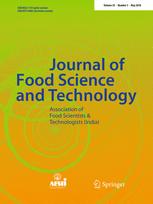Ver ítem
- xmlui.general.dspace_homeCentros e Institutos de InvestigaciónCIA. Centro de Investigaciones de AgroindustriaInstituto de Tecnología de AlimentosArtículos científicosxmlui.ArtifactBrowser.ItemViewer.trail
- Inicio
- Centros e Institutos de Investigación
- CIA. Centro de Investigaciones de Agroindustria
- Instituto de Tecnología de Alimentos
- Artículos científicos
- Ver ítem
Oxidative status of a yogurt-like fermented maize product containing phytosterols
Resumen
This work describes the formulation of a functional yogurt-like product based on fermented maize with added phytosterols and its oxidative stability during cold storage. The technological challenge was to stabilize 3.5% esterified phytosterols (between 2 and 3 g of free sterols) in a low-fat emulsion and to preserve the obtained product throughout processing and storage. The natural bioactive compounds: lutein, zeaxanthin, β-cryptoxanthin, β-carotene and
[ver mas...]
This work describes the formulation of a functional yogurt-like product based on fermented maize with added phytosterols and its oxidative stability during cold storage. The technological challenge was to stabilize 3.5% esterified phytosterols (between 2 and 3 g of free sterols) in a low-fat emulsion and to preserve the obtained product throughout processing and storage. The natural bioactive compounds: lutein, zeaxanthin, β-cryptoxanthin, β-carotene and γ-tocopherol were detected in the yogurt, and remained stable during 12 days of refrigeration. Higher content of C18:1 n-9 and C18:3 n-3 (six and ninefold, respectively) were obtained in samples with phytosterols. This was desirable from a nutritional point of view, but at the same time it induced lipid oxidation that was 1.4-fold higher in the product with phytosterols than in the controls. The use of a multivariate approach served to find descriptors which were related to treatments, and to explain their behavior over time.
[Cerrar]

Autor
Descalzo, Adriana Maria;
Rizzo, Sergio Anibal;
Servent, Adrien;
Rossetti, Luciana;
Lebrun, Marc;
Perez, Carolina Daiana;
Boulanger, Renaud;
Mestres, Christian;
Pallet, Dominique;
Dhuique-Mayer, Claudie;
Fuente
Journal of food science and technology 55 (5) : 1859–1869. (May 2018)
Fecha
2018-05
ISSN
0022-1155
0975-8402
0975-8402
Formato
pdf
Tipo de documento
artículo
Palabras Claves
Derechos de acceso
Restringido
 Excepto donde se diga explicitamente, este item se publica bajo la siguiente descripción: Creative Commons Attribution-NonCommercial-ShareAlike 2.5 Unported (CC BY-NC-SA 2.5)
Excepto donde se diga explicitamente, este item se publica bajo la siguiente descripción: Creative Commons Attribution-NonCommercial-ShareAlike 2.5 Unported (CC BY-NC-SA 2.5)

